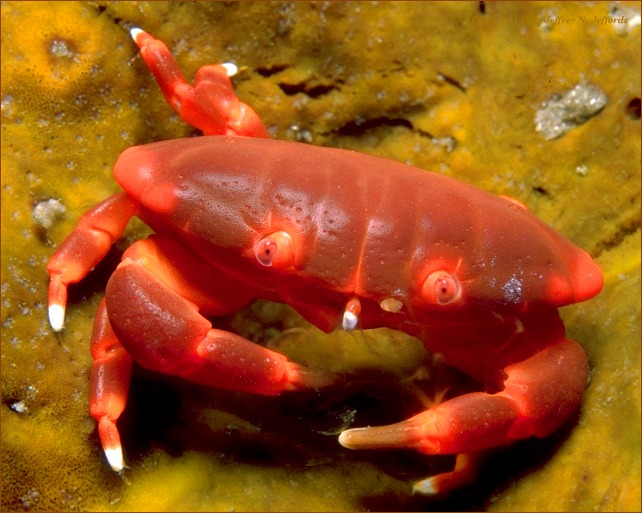 |
"Reef crab" is a general term for crabs that are not associated with some other distinctive characteristic or niche, and typically roam the reef without being confined to a certain piece of coral or host. This one has distinctive white tips on each appendage, and a beautiful deep reddish-orange color. The texture of its carapace is smooth and porcelain in appearance. This particular crab is less than one inch across in size-- I caught it in my lens as it slowly scurried across what appears to be the surface of a sponge. To a diver, crabs are among the most familiar inhabitants of the reef. They are often hard to spot in the daytime, hiding in crevices and under coral heads. Some, such as many of the smaller coral crabs, are typically easy to see but nearly impossible to reach (and to photograph). Their primary protection comes from hiding in the complex tree-like structures of hard coral branches, such as those of genus Acropora. Other small crabs seek shelter by the hundreds between the branches of hard corals. At night, many of the larger crab species emerge for feeding, though they are often hard to detect owing to their low profile and slow movement. The forward-most legs on a crab, called chelipeds, are not used for crawling. Most crabs are scavengers, such as the typical hermit crab. Some are herviborous, and some are filter-feeders, either by filtering scooped mud and detritus or by extending their specially adapted appendages called maxillipeds into the current. Examples of filter-feeders include the anemone-dwelling porcelain crabs and the hole-dwelling coral hermit crabs. Typically most crabs move in a sideways motion, though they can also crawl forward slowly. Looking at the legs of a crab can help describe its lifestyle; a crab with long, slender legs is better adapted for moving across mud flats (such as spider crabs). A crab with a specialized large pair of rear legs may use them for holding a sponge, as does the sponge crab. Some crabs can swim, such as the common edible blue crab Callinectes sapidus. Blue crabs have large, flat, paddle-shaped rear legs for swimming. Identification: Uncertain; suspect it is Liomera cinctimana |